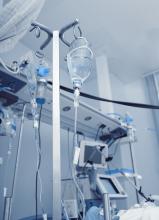An updated set of practice guidelines developed by the American Academy of Neurology recommends that patients with prolonged disorders of consciousness, such as a vegetative state or minimally conscious state, first undergo treatment for other outside symptoms and conditions to increase the likelihood of initial accurate diagnosis. The AAN also recommends that patients be evaluated by multidisciplinary specialists using standardized neurobehavioral assessments.
“People are sometimes misdiagnosed due to underlying impairments that can mask awareness,” guidelines first author Joseph T. Giacino, PhD, of Harvard Medical School, Boston, and Spaulding Rehabilitation Hospital, Charlestown, Mass., stated in a press release about the guidelines. “An inaccurate diagnosis can lead to inappropriate care decisions and poor health outcomes. Misdiagnosis may result in premature or inappropriate treatment withdrawal, failure to recommend beneficial rehabilitative treatments, and worse outcome. That is why an early and accurate diagnosis is so important.”
The practice guidelines, published Aug. 8 in Neurology, update the 1995 recommendations from the AAN on persistent vegetative state (VS) as well as a 2002 case definition of minimally conscious state (MCS) developed by the AAN, American Congress of Rehabilitation Medicine, and the National Institute on Disability, Independent Living, and Rehabilitation Research. In the new document, these same organizations made 18 recommendations about prolonged disorders of consciousness (DoC) based on three levels of evidence: Level A evidence was defined as the strongest recommendation, Level B evidence consisted of recommendations with a confident rationale and a “favorable benefit-risk profile,” and Level C evidence was the lowest level of recommendation that was still useful to clinical practice. Evidence was grouped into four different classifications based on the modified Grading of Recommendations Assessment, Development, and Evaluation process in a systematic review and based on “strong related evidence, established principles of care, and inferences.”
In the guidelines, the committee made the following recommendations:
- Medically stable patients with DoC should be moved to multidisciplinary care settings where specialists can “optimize diagnostic evaluation, prognostication, and subsequent management, including effective medical monitoring and rehabilitative care” (Level B).
- Patients should receive care for confounding conditions, receive serial standardized assessments, and undergo care that “optimizes arousal” to maximize initial accurate diagnoses (Level B).
- Clinicians should communicate to families of patients with prolonged DoC that adult patients in an MCS caused by traumatic injury tend to have “more favorable outcomes,” compared with patients who are in a VS and patients with unresponsive wakefulness syndrome (UWS) caused by a nontraumatic injury (Level B).
- Clinicians must discuss long-term care with families of patients with prolonged DoC and a poor prognosis (Level A), indicate that not all patients of this type have a poor prognosis, administer Coma Recovery Scale–Revised, and perform imaging, such as structural MRI and single-photon emission CT, to determine prognosis in these patients (Level B).
- Regarding discussion of long-term care with families of children with prolonged DoC, clinicians should acknowledge that prognostic assessment, treatment, and natural history of recovery is not well-defined for children with prolonged DoC (Level B).
- In patients with traumatic VS, UWS, or MCS, amantadine should be prescribed (100-200 mg) between 4 weeks and 16 weeks after injury to lower the risk of disability and increase the likelihood of functional recovery (Level B).
- Clinicians should always assess and treat pain as well as discuss “evidence supporting treatment approaches” (Level B).


